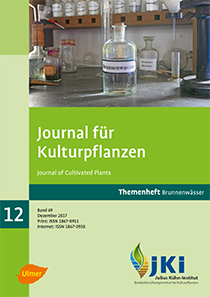Elemental composition of German well waters: Part 4 – Significance of main components
DOI:
https://doi.org/10.5073/JfK.2017.12.04Keywords:
Principal Component Analysis (PCA), discrimination analysis, well water, major and trace elementsAbstract
Multivariate statistical analysis is a powerful tool to investigate structures in large data sets. Depending on their stratigraphic and hydrographical origin, and hydrogeochemical type well waters contain numerous elements in a wide range of concentrations. The Institute for Crop and Soil Science of the Julius Kühn-Institut in Braunschweig, Germany maintains a database with concentrations of 67 chemical elements in 637 German well waters. The method of choice to explore the structures of such large data set is data reduction through principal component analysis (PCA) by which a subset of uncorrelated theoretical variables is calculated. These theoretical variables are called principal components (PC) and they adequately explain the variation observed within a large number of variables in the original variable by a much lower number of PCs. From 67 variables 19 PCs with an eigenvalue > 1 were extracted. The first three PCs explained a third of the variability observed in the entire dataset. The highest loading variables of these 3 PCs were Cs, Dy, Er, Ge, Gd, Lu, Nd, Rb, Sm, Y and Yb. The significant role of rare earth elements for the stratigraphic, hydrogeological, and hydrogeochemical classification of well waters was confirmed by means of discriminant analysis. 16 elements were most abundant among the first 10 coefficients of the significant functions for discriminating between stratigraphic, hydrogeological and hydrogeochemical classes. Lu and Tm were found 6 times, Er, Dy and Zr 5 times, Gd and Sm 4 times, Ca, Cs, Hf, Ho, Li and Rb 3 times, Mg, Pr, Y, Yb and Nd 2 times and finally La, Na and S 1 time. The chemical elements commonly used to characterise well waters such as Ca, K, Mg and Na were only contributing to significantly discriminating functions between hydrogeochemical Piper classes.
Downloads
Published
Issue
Section
License
The content of the journal is licensed under the Creative Commons Attribution 4.0 License. Any user is free to share and adapt (remix, transform, build upon) the content as long as the original publication is attributed (authors, title, year, journal, issue, pages).
The copyright of the published work remains with the authors. The authors grant the Journal of Cultivated Plants, the Julius Kühn-Institut and the OpenAgrar repository the non-exclusive right to distribute and exploit the work.







